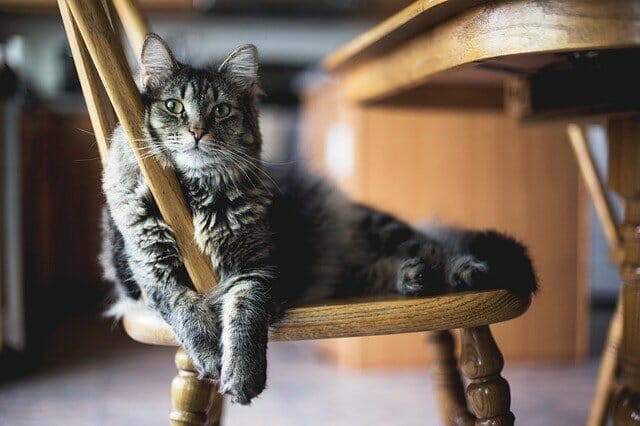How Long Do Cats Live on Average: Factors That Impact a Cat’s Life Expectancy
According to Vest West, cats live for 12-18 years. However, many factors can affect a cat’s lifespan, including genetics, diet, exercise, and medical care. Some cats may live into their 20s, while others may live for only a few years. In addition, indoor cats tend to live longer than outdoor cats since they are not exposed to the same risks, such as traffic accidents and fights with other animals.


Table of Contents
Factors That Impact a Cat’s Life Expectancy
Genetics
Genetics can play a significant role in a cat’s life expectancy. Certain breeds may be predisposed to health issues that can impact their lifespan. For example, Persian cats may be more prone to kidney disease, while Siamese cats may be more susceptible to respiratory problems.
Additionally, genetic factors can impact a cat’s overall health and well-being, which can, in turn, affect its lifespan. For example, some cats may have a stronger immune system or a better ability to fight diseases, while others may be more prone to infections and illnesses.
Genetic factors can also influence a cat’s personality and behavior, impacting its lifespan. For example, cats with a more aggressive or fearful temperament may be more prone to accidents or injuries that can shorten their lifespan.
Diet and Exercise
A balanced diet and regular exercise are essential for maintaining a cat’s health and can help prevent various health issues that can shorten its lifespan.
Cats are obligate carnivores, requiring a diet high in animal-based protein. A diet that is low in protein or contains low-quality protein sources can lead to various health problems, including obesity, diabetes, and kidney disease.
Providing your cat with an appropriately balanced diet regarding nutrients, vitamins, and minerals is also important. Please consult your veterinarian to determine the best diet for your cat based on age, activity level, and any underlying health conditions.
In addition to a healthy diet, regular exercise is important for maintaining a healthy weight and preventing obesity-related health issues. Encourage your cat to play and engage in physical activities like running, jumping, and climbing. Providing toys and a scratching post can also help keep your cat active and mentally stimulated.
Medical Care
Regular medical care is crucial for maintaining a cat’s health and detecting and treating health issues early. Cats should receive routine veterinary care, including annual check-ups and vaccinations, to help prevent common illnesses and detect potential health issues early on. It’s also important to keep up with regular dental cleanings and to monitor your cat’s weight and overall health.


Suppose you notice changes in your cat’s behavior or health, such as a loss of appetite, lethargy, or other unusual symptoms. In that case, bringing them to the veterinarian for a check-up is important. Early detection and treatment of health issues can help prevent more serious health problems and improve your cat’s quality of life.
In addition to routine veterinary care, it’s important to provide your cat with preventative care, such as regular flea and tick prevention, to help protect against common parasites and diseases. Keeping your cat indoors can also help prevent exposure to outdoor hazards and reduce the risk of injury or illness.
Indoor vs. Outdoor Lifestyle
Indoor cats typically have a longer lifespan and are less likely to be exposed to outdoor hazards such as cars, predators, and infectious diseases. In addition, indoor cats also have a lower risk of injuries and can be protected from environmental toxins and other hazards.
However, indoor cats may be more prone to obesity and other health issues related to a sedentary lifestyle. Therefore, providing indoor cats with plenty of opportunities for physical activity and mental stimulation, such as toys, scratching posts, and interactive play, is important.
Outdoor cats have more opportunities for exercise and exploration and may enjoy a more stimulating environment. However, outdoor cats are exposed to more hazards and are at risk of injuries, infectious diseases, and exposure to environmental toxins. Outdoor cats may also contribute to environmental problems, such as the predation of native wildlife.
If you allow your outdoor cat access, it’s important to protect their safety by providing a secure outdoor enclosure or limiting their access to certain areas. You should also ensure that your cat is up-to-date on vaccinations and preventative care, such as flea and tick prevention.
Neutering/Spaying
Neutering and spaying are surgical procedures that involve removing the reproductive organs of a cat. Neutering involves the removal of the testes in male cats, while spaying involves the removal of the ovaries and uterus in female cats. There are several benefits to neutering and spaying cats. These include:
- Preventing unwanted litters: Neutering and spaying cats is an effective way to prevent unwanted kittens. This can help reduce the number of cats in animal shelters and the overall cat population.
- Reducing the risk of certain health problems: Neutering and spaying cats can help reduce the risk of certain health problems, such as uterine infections and some types of cancer.
- Reducing unwanted behaviors: Neutering and spaying cats can also help reduce unwanted behaviors, such as spraying and aggression.
- Reducing roaming and fighting: Male cats not neutered are more likely to roam and fight with other cats, increasing their risk of injury and exposure to infectious diseases.
- Improving the overall quality of life: Neutering and spaying can improve cats’ overall quality of life by reducing stress and improving their social behavior.
Environmental Factors


Environmental factors can also impact a cat’s life expectancy. For example, some factors that can affect a cat’s health and longevity include exposure to environmental toxins such as household chemicals, pesticides, and tobacco smoke, which can increase the risk of certain cat health problems.
Cats require access to clean and fresh water to stay hydrated and healthy. Lack of access to clean water can lead to dehydration and other health problems. For example, cats that spend time outdoors or in contact with other cats are at a higher risk of exposure to infectious diseases such as feline leukemia virus (FeLV) and feline immunodeficiency virus (FIV).
Stress and anxiety can hurt a cat’s health and well-being, leading to various health problems. For example, extreme hot and cold temperatures can harm a cat’s health and well-being.
Breed
The breed can also play a role in a cat’s life expectancy. Different breeds of cats may be predisposed to certain health conditions that can affect their lifespan. For example, some breeds may be more prone to certain types of cancer, heart disease, or kidney disease.
Mixed-breed cats generally tend to have a longer lifespan than purebred cats. This is because purebred cats are often bred for specific physical traits, which can result in health problems due to inbreeding and genetic predispositions.
